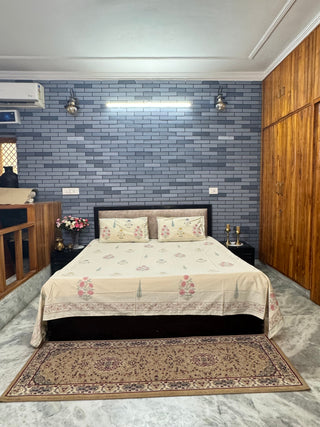Rajasthan is known for its rich culture and heritage. Being a sociologist, I am always interested in the historical essence, vibrancy, social setup, colourful mix of cultural and tradition of the place.
The colourful cloth and apparels of Rajasthan always have a magnetic affect on me. Rajasthan is so rich in block printing and colour dying work. To know more and more about block printing, Bagru in Rajasthan is the place to go to. The centuries-old traditional art of hand block printing, is exclusively known as Bagru hand block printing.
The use of natural colour dyes makes the art form and the process of making the Bagru cloth, eco-friendly and sustainable.
Bagru print is a traditional form of block printing that has its origin in the village of Bagru in Rajasthan, India. It involves the use of wooden blocks to create intricate patterns on fabric using natural colour dyes. Bagru print, is a traditional form of block printing, is renowned for its intricate patterns and vibrant colours. Each piece of fabric is meticulously handcrafted using wooden blocks and natural colour dyes, creating unique and timeless designs.
The process typically includes several stages, such as preparing the fabric, creating the design on the wooden blocks, and then printing the design onto the fabric. Bagru print is known for its unique motifs and vibrant colours, and it has gained popularity both in India and internationally for its craftsmanship and cultural significance.
This art of printing is mainly done by the Chippa community. It has long old history believe to originated in 16th century and reached its peak in 19th century. In today’s era it is again getting its pace. It is an elegant and mesmerising art in block printing. Artisans uses the age old traditional way of creating this art. They use natural colour dye for printing and are handcrafted.
Below is the general overview of the process of making different colours in Bagru print:
Fabric Preparation:
Cotton fabrics are commonly used for Bagru printing. The fabric is washed and treated to remove any impurities or sizing agents.
Block Carving:
Skilled artisans carve intricate designs onto wooden blocks. These blocks can have various patterns and motifs that represent traditional or contemporary themes.
Natural Colour Dyes:
Bagru prints primarily use natural colour dyes derived from plant sources, minerals, and other organic materials. Some common natural colour dyes include:
- Indigo: for shades of blue.
- Manjistha: for red tones.
- Haldi (Turmeric): for yellow
- Dhavdi (Harda): for green.
- Alizarin: for various shades of red.
Mordants:
Mordants are substances that are used to fix the natural colour dyes onto the fabric. Common mordants include alum, iron, and tannin. Different mordants can alter the colour and fastness of the colour dyes.
Colour Dyeing Process:
- The fabric is soaked in a solution of the chosen mordant to prepare it for colour dyeing.
- The wooden blocks are dipped into the natural colour dye and then pressed onto the fabric, leaving behind the pattern. This process is repeated to cover the entire fabric.
Washing and Sun-drying:
- After the printing is complete, the fabric is washed to remove excess dye and mordant.
- The washed fabric is then sun-dried, allowing the colours to set and the fabric to attain its final appearance.
Additional Block Prints:
Multiple blocks may be used to create complex and layered designs. Different blocks are employed for different colours and patterns.
Finishing Touches:
Some Bagru prints involve additional processes like hand-printing or embellishments to enhance the design.
The traditional Bagru printing process relies on the craftsmanship of skilled artisans, and each step contributes to the unique and vibrant colours associated with this form of block printing. The use of natural colour dyes adds an eco-friendly dimension to the craft, and the process has been passed down through generations.


